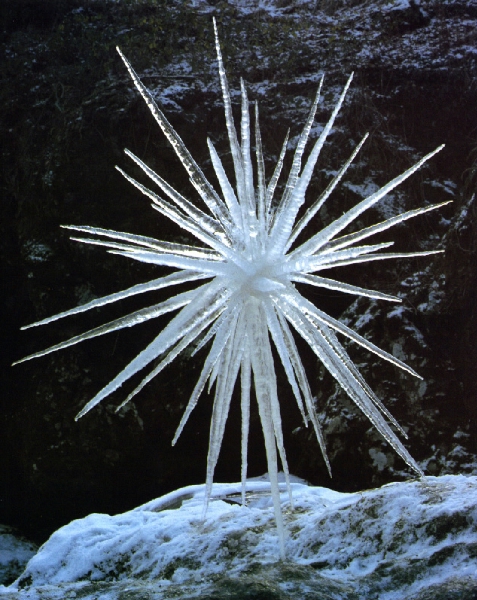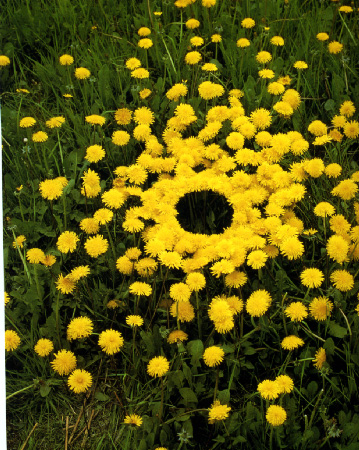Portfolio: Sculpture Studio
Rachael Lashof
Project 1- Process
ARTIST RESEARCH:
Look up the work of at least two other artists and comment on the specific way their work makes meaning through process.
Eduardo Kac and Andy Goldsworthy
Eduardo Kac:
Eduardo Kac is an artist that I was first introduced to in a lecture last
semester (Fall ’04) by Linda Weintraub. His work is particularly
interesting because it borders on the line between science and art.
 Most
well know is the “GFP Bunny” project in which he genetically
engineers an albino rabbit with the wild-type green fluorescent gene found
in jellyfish. However, this project goes far beyond the end product of
a rabbit named Alba (at left) that fluoresces green when illuminated with
blue light. As he discuses on his webpage,
Kac’s “GFP Bunny” project also includes (1) discussions
with professionals and the public, (2) in depth research into the relationship
between genetics, organisms, and the environment, (3) interaction with
the bunny including in public presentations, (4) an examination of what
is ‘normal,’ (5) “expansion of the present practical
and conceptual boundaries of artmaking to incorporate life invention,”
and as several other points, as Kac lists.
Most
well know is the “GFP Bunny” project in which he genetically
engineers an albino rabbit with the wild-type green fluorescent gene found
in jellyfish. However, this project goes far beyond the end product of
a rabbit named Alba (at left) that fluoresces green when illuminated with
blue light. As he discuses on his webpage,
Kac’s “GFP Bunny” project also includes (1) discussions
with professionals and the public, (2) in depth research into the relationship
between genetics, organisms, and the environment, (3) interaction with
the bunny including in public presentations, (4) an examination of what
is ‘normal,’ (5) “expansion of the present practical
and conceptual boundaries of artmaking to incorporate life invention,”
and as several other points, as Kac lists.
Another “transgenic art” project that Eduardo Kac has taken
on is Genesis – in which Kac allows the viewer to genetically mutate
bacteria in a gallery by switching on an ultraviolet light. In addition
to  his
“transgenic art,” Kac has a large interest in telecommunications
and the interactions of real people with created program people in a virtual
web-based environment. One work exploring this was Uirapuru, in which
a flying fish was hung above a forest in the gallery and responded to
local and web-based commands. Local and remote viewers were able to interact
with the flying fish in a virtual world, where the robotic birds respond
to the rhythm of Internet traffic.
his
“transgenic art,” Kac has a large interest in telecommunications
and the interactions of real people with created program people in a virtual
web-based environment. One work exploring this was Uirapuru, in which
a flying fish was hung above a forest in the gallery and responded to
local and web-based commands. Local and remote viewers were able to interact
with the flying fish in a virtual world, where the robotic birds respond
to the rhythm of Internet traffic.
Eduardo Kac’s work is particularly interesting to me because of my interests in the intersections between art and science. To me, the “GFP Bunny” raises many interesting and important questions to both the scientific and artistic communities. Alba inspires viewers to think about (1) what biological manipulations we are we capable of, (2) are biological manipulations artwork, (3) what effects do our own actions (even simple) in the environment have on organisms and other elements of nature.
Andy Goldsworthy:
My interest in art and its intersections with science continues with British
artists, Andy Goldsworthy. Like Eduardo Kac, Goldsworthy has a deep interest
in human interaction with nature. For Kac, this interest is in the manipulation
of biological organisms. For Goldsworthy, this interest is in the manipulation
of our surrounding environment. “I want to get under the surface.
When I work with a leaf, rock, stick, it is not just that material in
itself, it is an opening into the processes of life within and around
it. When I leave it, these processes continue,” states Goldsworthy.

 Not
only is the making of these patterns from natural elements a process in
itself, but so is their existence, constantly being changed by light,
weather, and other effects, and possibly even being destroyed by these
effects. “Movement, change, light, growth, and decay are the lifeblood
of nature, the energies that I try to tap through my work. I need the
shock of touch, the resistance of place, materials and weather, the earth
as my source. Nature is in a state of change and that change is the key
to understanding. I want my art to be sensitive and alert to changes in
material, season and weather. Each work grows, stays, decays. Process
and decay are
Not
only is the making of these patterns from natural elements a process in
itself, but so is their existence, constantly being changed by light,
weather, and other effects, and possibly even being destroyed by these
effects. “Movement, change, light, growth, and decay are the lifeblood
of nature, the energies that I try to tap through my work. I need the
shock of touch, the resistance of place, materials and weather, the earth
as my source. Nature is in a state of change and that change is the key
to understanding. I want my art to be sensitive and alert to changes in
material, season and weather. Each work grows, stays, decays. Process
and decay are  implicit.
Transience in my work reflects what I find in nature.”
implicit.
Transience in my work reflects what I find in nature.”
Andy Goldsworthy’s work is a comment not only on his appreciation for nature and process in art, but especially about the fact that nature itself is a process. What better way to artistically represent nature as an ongoing process by making art that becomes part of that process? The ice spiral surrounding a tree and the ice star with both eventually melt as temperatures rise. The dandelion pattern Goldsworthy has created in the field will eventually go away as wind blows the flowers, or they themselves move on in their life cycle or die.
Andy Goldsworthy’s artwork is interesting to me for its appreciation of the fact that nature is ephemeral – it is always changing, dying, re-growing. He shows a true admiration for nature’s patterns and process – and they are undoubtedly amazing. Like Kac, Goldsworthy again raises the question of what effects do our own actions (even simple) in the environment have on organisms and other elements of nature.
St. Mary's College of Maryland
St. Mary's City MD 20686-3001
Back to Index
This page was last updated: February 3, 2005 3:30 PM